A few jump-turns later, the skier comes to a stop above a precipice. The cascade of water-ice above which he sits sheens in the afternoon light. A moment passes. Then two.
Suddenly, he faces downhill and launches off the ice cliff. A wave of cheers erupt across the bowl as he stomps the landing. A few hundred feet below him, another skier lies collapsed in pain with two broken legs. Welcome to Tuckerman Ravine.
High on the eastern slopes of Mt. Washington in New Hampshire is the so-called “American birthplace of extreme skiing” — Tuckerman Ravine. The ravine, technically a glacial cirque, develops a snowpack 50 feet deep each winter. Any visit then requires the need to manage avalanche danger along with the infamous arctic weather the peak receives. But when spring arrives, the snow-pack stabilizes, and the weather lets up to provide a few more blue-bird days. When that happens, skiers from the Northeast and beyond flock there to test their mettle on its slopes. Plenty of non-skiers go there too for a different reason: To witness perhaps the most absurd mountain entertainment available in all of North America.
I awoke in the Conway Walmart parking lot on a Saturday in April. I was set on riding the ravine. There were plenty of vans, RVs and SUVs sleeping beside me — likely with the same intentions. I drove the half-hour to Pinkham Notch, arriving at 8:30 a.m. Late for most forays into the mountains, but the snow in the ravine wouldn’t be soft enough until the afternoon, and I could hike the approach pretty quickly.
It seemed like all of Boston as well as New York City was there that morning too. They arrived much earlier than me to boot. The main parking lot was chock-full, and I ended up parking at the last “spot” in the overflow lot, squeezing my truck atop a patch of grass in a corner.
I packed my bag, munched some breakfast and started hiking up. The approach to the floor of the ravine at 4,400 feet of elevation is about 3 miles and 2,400 feet of gain. I’d done this hike several times this winter for ice climbing trips, seeing relatively few people. This time it was a conga-line of skiers, snowboarders and hikers.
The diversity of styles on the way up were remarkable. There were backcountry skiers with their setups A-framed on their backpacks, snowboarders carrying their boards like Jesus carried the cross, people with their skis counter-balanced over a shoulder, and even a pair of skiers marching in unison with their skis suspended across each other’s shoulders — which I don’t think lasted very long. They were all driven to push through their various levels of comfort or discomfort by one thing: Tuckerman Ravine.
I arrived at the bowl a little before noon. There was a small but growing crowd on the floor. I spotted two snow rangers with their bright-red jackets. This being the wilderness, it’s essentially anarchy as to what you can do and what risks you can take. Even so, they station themselves here on days like this so they can try their best to stop people from killing themselves. That was shaping out to be a tough proposition.
From here there’s a full view of the entire ravine, with each run visible. Left Gully and Right Gully are the easier and the most-commonly skied runs. A deep boot pack was shaped up Right Gully. There were already over two dozen people climbing up it. It was a 30 to 35-degree snow slope, where if you slipped, you’d go for a long slide, hit other people, and then collide with a rock band below. That is unless you had an ice axe to stop yourself — not many of which were to be seen. You would also be ascending in close proximity to the frequent crashes down the run. One needs only to look at the Mt. Washington accident reports to see how often these things happen.
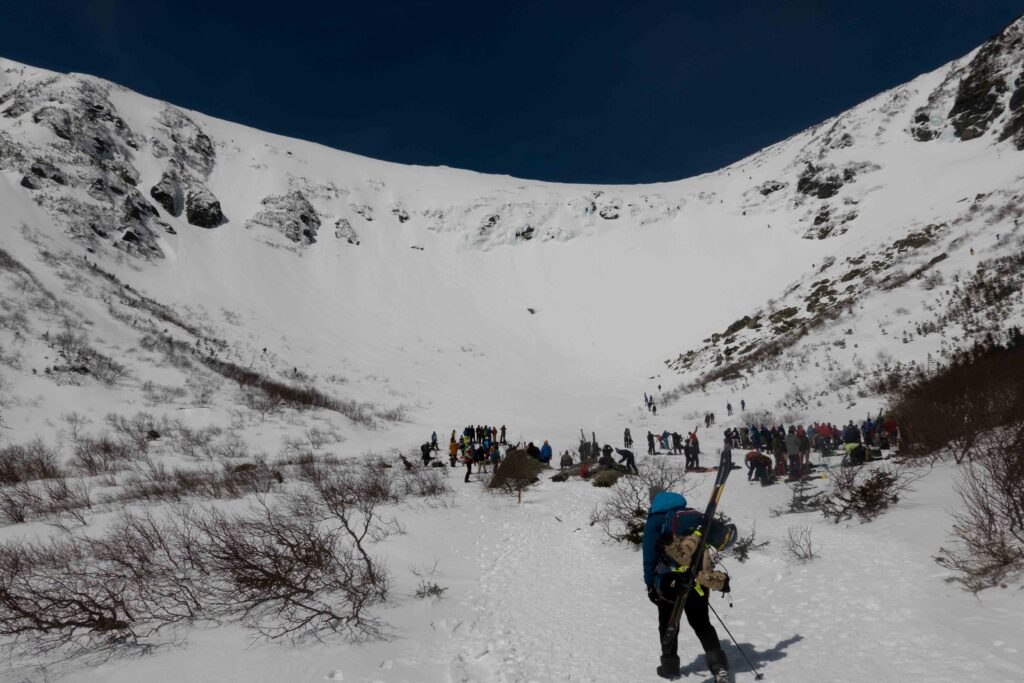
Looking at the main bowl, the most frequented run here is “The Lip.” Aptly named, it starts as a sudden rollover down a 40 to 50-degree slope, and then narrows between some rock and ice before opening up onto the rounded slopes of the lower ravine bowl. In full view of the crowd, there was a skier gripped in the choke point of the Lip. He was balancing on his edges partway through the run. A hundred feet above him, another skier was suspended on the slope as well, either scared themselves or waiting for the way to clear. A nearby skier remarked as to what they were doing not moving in the most dangerous part of the slope. I had no clue as the snow seemed sunny and soft, but 2021 was a weird and wet winter, and conditions were anything but predictable.
I wanted to ride the Lip. Given the crowds developing up the gullies, I decided to lay a boot pack directly up the bowl so I could ascend the most direct and crowd-free way. I donned crampons and an ice axe. I started marching up. I passed by “Lunch Rocks” – so named because it’s a rocky area where people have lunch while watching the shenanigans. I followed in the shallow boot-prints of a mountaineer a hundred feet above me, who wasn’t skiing but climbing the peak by way of the snowy ravine – a far more interesting route.
The snow was hard and icy. With my flexy splitboard boots and the aluminum crampons I was testing, booting up these slopes took longer than I bargained for. I’d have to kick a step three times with the front of my boot for the in-cut to be sufficient in holding my weight. I ascended like that, slowly but steadily.
The crowd at the ravine floor was now larger and rowdier. They were fervently watching skiers and snowboarders make their descents. There are three things you could do to earn the audience’s applause: You could huck a cliff; you could descend at Mach. 20; or and by far the most frequent option, you could crash. One clever snowboarder decided he’d go for a combo, and he shot out of the Lip like a bullet, crashed on his ass, and slid the entire way down at exorbitant speeds.
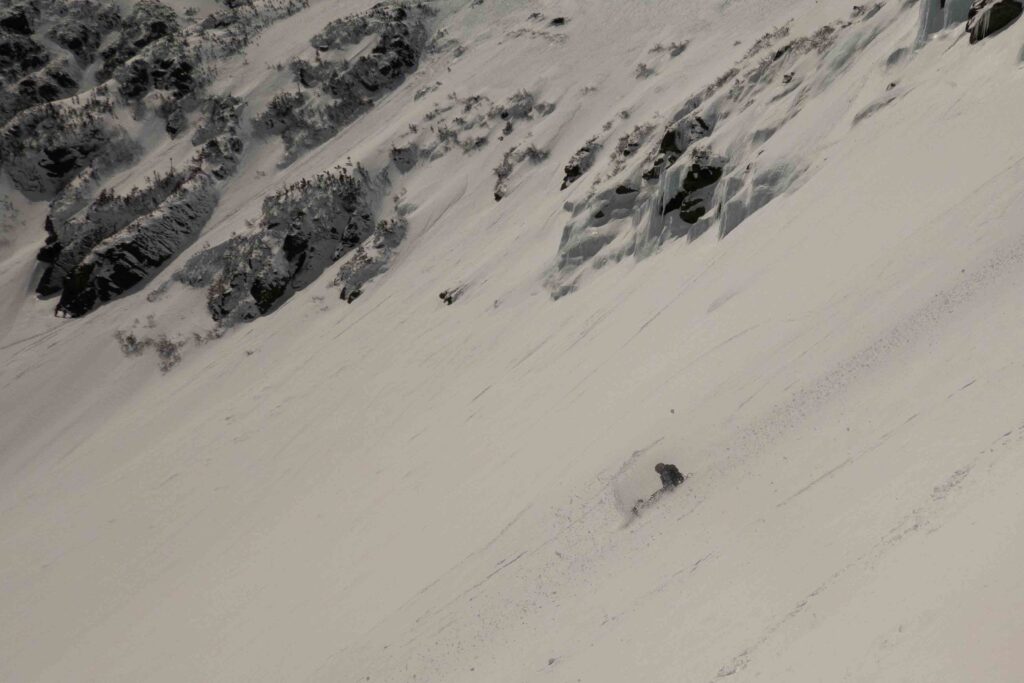
Another skier flew down making nary a turn, with the chattering of his skis on the surface apparent for all to hear. He earned a healthy round of cheers as well.
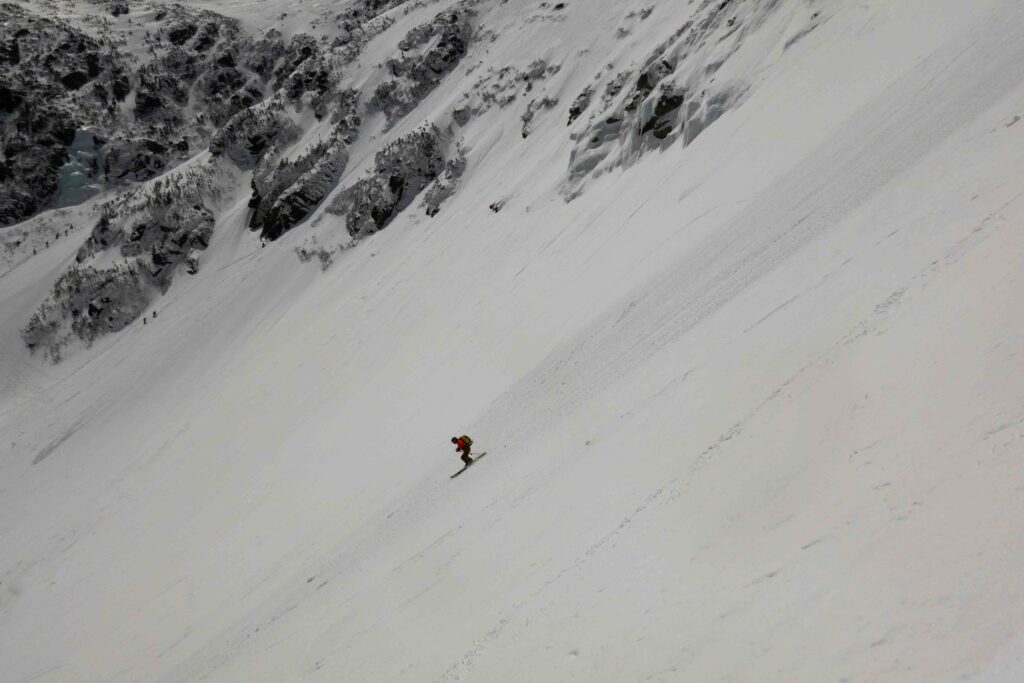
As I approached the crest, the climber I was following inexplicably started ascending through the narrowest point of the run. To be fair, he was to the side; but with the frequency of crashes, I didn’t want someone to collide with me. I opted to continue straight up through some chutes and around a rock band. I climbed, and the surface began to resemble something closer to the ice I’d climbed last week in neighboring Huntington Ravine. Not the soft snow I was hoping for. My upward progress slowed even more as I began navigating more carefully, hunting and kicking hard through whichever soft patches I could find. I even chopped a few steps with the adze of my ice axe like the olden days.
Another skier climbing below me lay waiting at the intersection of our tracks. He was pondering which way to go. I could almost hear his thoughts: “Would I rather risk getting hit by a crashing skier, or do some sketchy pseudo-ice climbing?” He chose the ice.
After that bit of sketch — which a good day in the mountains is never complete without — I arrived past the top of the Lip. Only the snowfields are ahead of me. These are lower-angle snow slopes situating the top of the ravine, that extended from the summit 1,000 feet higher.
I ascended a few hundred more feet so I could warm up with easy turns on the snowfields before riding the Lip’s icy slopes. I climbed up and found a comfortable rock to sit down on and transition to my splitboard. At this point, clouds had blocked the sun, and it was shady. It was also below freezing up here, which meant the snow would harden even more. I decided not to dwindle and started riding down the snowfields. Somehow, these slopes were perfect corn, and I made smooth and soft turns the whole way through.
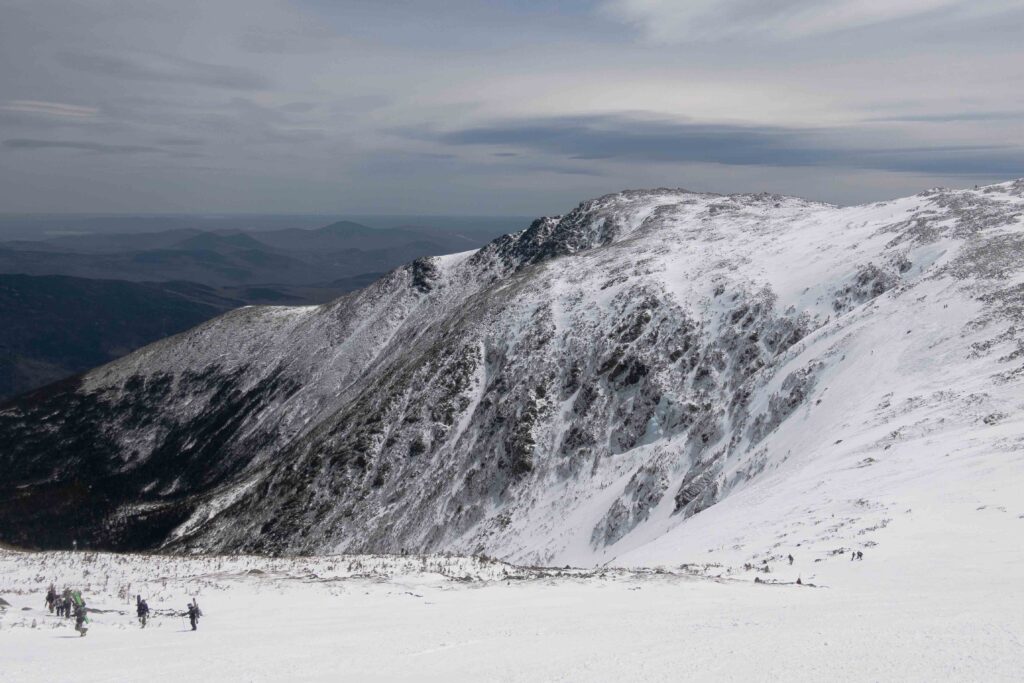
I arrived at the top of the Lip, and there was a line of about 10 people – either waiting to drop in or reconsidering the life decisions that led them up to that point. The sound of scraping edges as people tried to turn on the choppy surface wasn’t nice on the ears. A few people went ahead, and then no one. A voice rang out: “Who wants to go next?” I figured I’d give it my shot and I started riding down.

I began on my heel-edge, which was the only option given my entrance to the slope. As I turned on 50-degree choppy, scraped snow; I immediately lost my edge. I started sliding, and arrested by digging in the pick of my ice axe. I was 100 feet downhill by the time I stopped myself – this slope was certainly steep. Not one to be discouraged, I stood up and began to ride again. I picked up some speed, put some more pressure on my edge, and it skidded out again!
Now I was on my ass going too fast to arrest, much like the snowboarder who careened past me. In all my infinite wisdom I decided to attempt turning onto my toe-edge, while I was still sliding. This of course turned my slide into a somersault. I came to a stop with my body inverted after a violent tumble. But now, I was out of the crux and on more open slopes; battered, but uninjured. I picked my way down the rest of the ravine. Trying to save face, I hit a jump someone built on the floor. I landed and crashed once again – this time in front of everyone – and received a dose of sarcastic but in-good-faith cheers.
I blamed my tired legs from all the step-kicking, but I would soon come to find out that I forgot to engage the high-backs on my splitboard! No wonder my heel edge wasn’t working. It wasn’t lack of ability but lack of intelligence that caused the crash — not sure what’s worse.
I started preparing to ascend again so I could give the run another go. All of a sudden, everyone’s eyes drew up. A skier was descending The Lip at a good speed. He couldn’t even make a single turn before he was caught on the same patch of chop as I did. Cheers flared up as he went down. But he didn’t stop there. As he rolled over one of his skis released and remained at the top of the run. After that he took flight. His figure tomahawked and rag-dolled as it bounced down the snow, catching 20 feet of air at times. It was a blurry haze of limbs. The single ski that stayed attached was wrenching his legs in every direction. That ski finally let go 400 feet below the first, and his body slid the rest of the way down. It came to a stop above Lunch Rocks. He laid, motionless.
The cheers had been replaced by cries of “Holy shit!” and “Whhooahhh.” Some of the people at Lunch Rocks approached and inspected his figure. Soon after they sounded three blows of a whistle — the backcountry SOS signal. The snow rangers grabbed an orange rescue litter that they had with them and went up.
We weren’t sure if we saw someone die or just suffer major injuries. But, it seemed to be dealt with by the rangers and people at Lunch Rocks. Everyone got back to what they were doing. In hindsight, this was textbook bystander effect: With a 200-person crowd present, the personal responsibility and influence of the event was diffused 1/200th-fold. As I write this, I let myself get included in the effect, and unfortunately didn’t think to do anything.
I continued to transition for my next run of the Lip. As I shouldered my backpack, a shriek rang out from the crowd. Another skier was now rag-dolling down. Both his skis were released early in the tumble. Still, he was on an uncontrollable slide down the entire bowl. He rolled, sometimes head over heels, much of the way. Plumes of snow flew up along his path. Their companion was full witness to this, hence the shriek.
He came to a stop a mere 20 feet above the first casualty. Well, that was convenient. It’s like getting in a car crash, but right in front of an ambulance. He too remained motionless, but the rangers brought him down next to the first and began to tend to him.
I started hiking up now. As I marched, a descending skier from Right Gully who overheard the scene rode by. He said the first guy had one or two broken legs, while the second had something wrong with his neck or back. Ouch. And those were only the injuries apparent at the scene. Who knows what else the hospital would find.
The boot-pack I had helped to lay that morning had now become a staircase of snow. It must have seen more than 50 people ascend after me. The going was much faster now, and I climbed up with ease.
Then, as if two skiers weren’t enough, a snowboarder crashed. She slid the whole way down, hooting and hollering. Right when I thought she would collide with the rescuers at the bottom, she came to a stop. She stood up, okay and completely unharmed.
This was now becoming a problem. The patients were in the firing line of the Lip. People who were ascending in the gullies or at the top would have no idea of the blockage at the bottom. They wouldn’t be able to see it either. The lip is convex – you only see the view at the rollover, and by then you’ve already committed to the run.
Fortunately, rescuers and rangers started to transport the patients down in a hand-carried rescue litter. If they would have needed a helicopter, it would have required a complex long-line rescue in the ravine bowl. The chopper would also be at the mercy of the peak’s dangerous winds and cloud cover. Thankfully, broken bones don’t need immediate treatment. The litter transport could commence. The rangers and SAR volunteers here work tirelessly on searches and rescues. The over 150 deaths and countless more injuries and incidents on the peak are testament to their efforts.
I reached just below the choke point of the run. A skier and snowboarder were transitioning here for their descent. They witnessed the crashes first-hand. The full iciness of the Lip was laid right in front of us, and they rightfully decided to ride from here rather than up there.
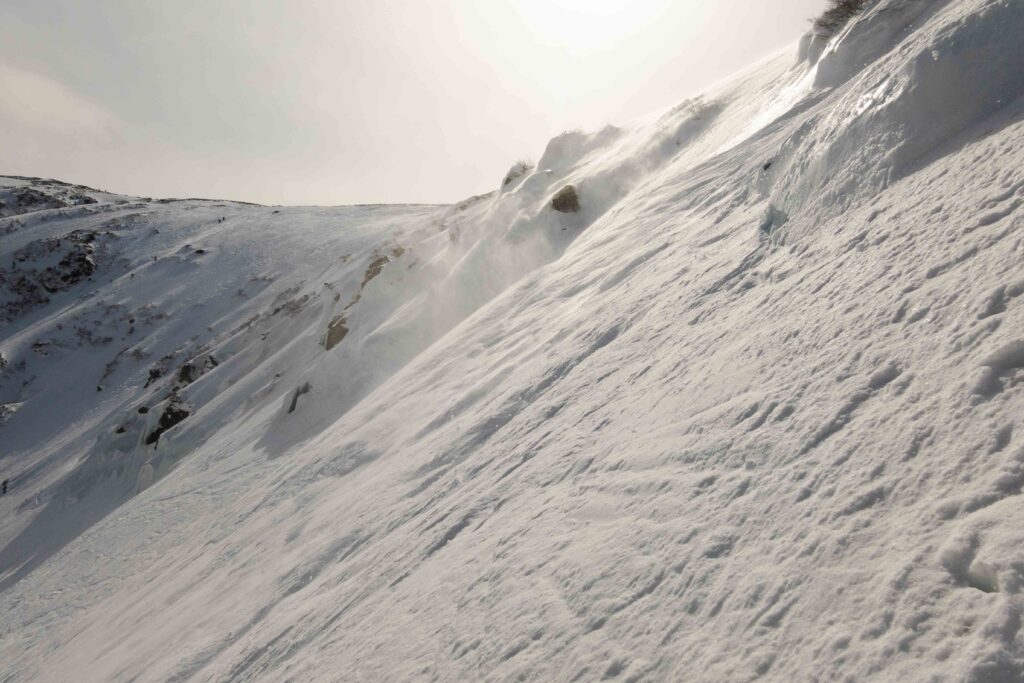
I took a break and relaxed, snapping photos. A descending skier made his way down and hung by me. He was waiting for his friend up above, who was stuck at the top of the run. The ice wasn’t a reassuring sight for sure. While observing, I dropped my sunglasses. We both watched as it comically slid down the entire ravine, only coming to a stop near Lunch Rocks. When that happened I was ready to transition and ride down myself to save it. But, the descending skier offered to collect it and leave it on top of an obvious triangle-shaped rock. I was thankful and then resumed climbing. I could now get my second chance at the Lip.
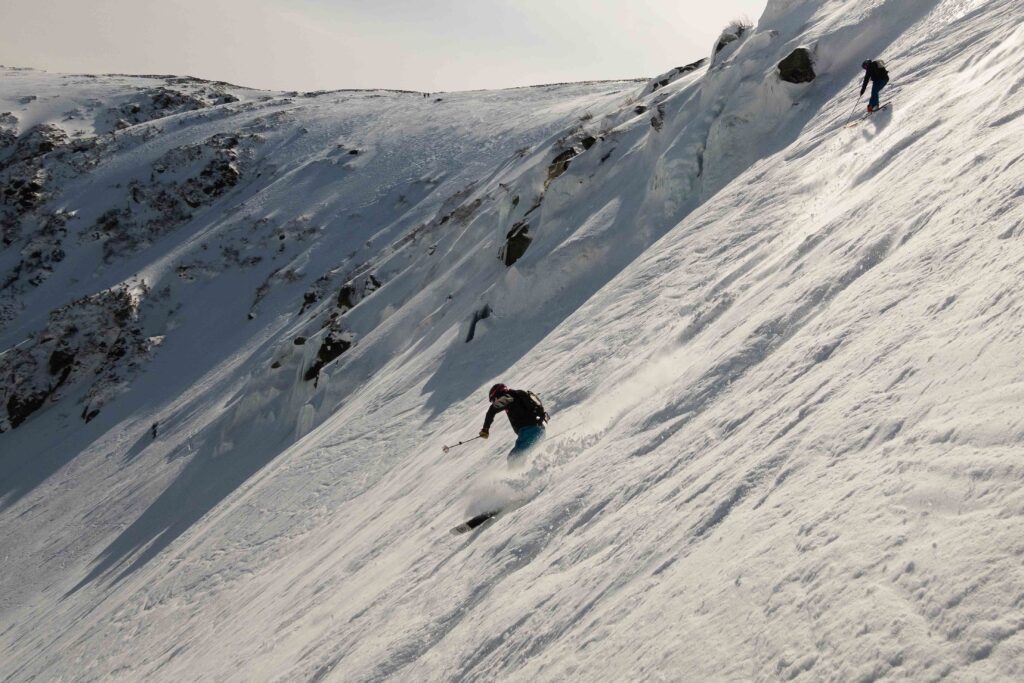
Despite the constant carnage, I was still willing to ride. If I couldn’t make clean turns, I would just turn on my toe-edge, face my ice axe against the wall, and hold a traverse down. That’s one advantage of a snowboard — you can descend any slope like that. Albeit not in a clean fashion.
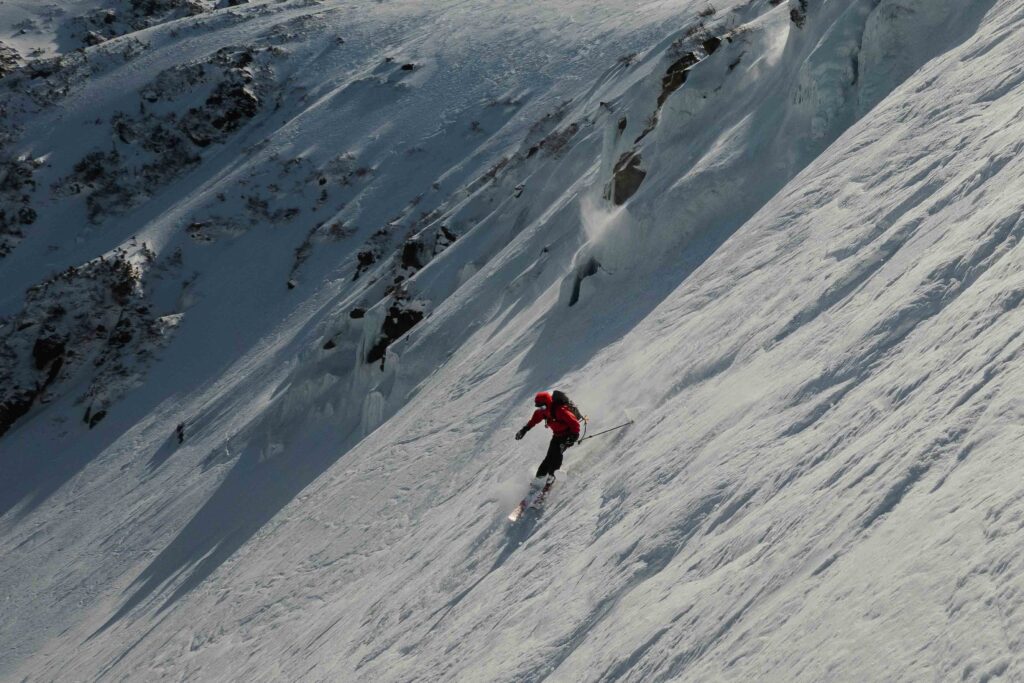
I climbed up to 100 feet above the slope’s rollover. I transitioned to downhill mode here, rode down the snowfields, and stopped at the top. There was another snowboarder here, slowly descending. He was gripped, standing on his toe-edge and bracing against the wall — probably deciding if he should give turning a shot. I sat down and waited for the way to clear. I had a view of the ravine floor, and the crowd had dwindled. It was late afternoon now, and the sun was dying. This would be my last run of the day.
The run cleared, and I entered on my heel-edge. Right at the 50-degree chop, I turned to my toe-edge and rode past the crux. But, at that point, standing on the slope; I chose to play it safe. I half-traversed and half-scraped my way through the rest of the choke point, remaining on that edge. On the better slopes below, I began to turn, and reached Lunch Rocks a few minutes later. Not an awe-inspiring send by any means, but an adrenaline-filled descent nonetheless.
At Lunch Rocks, I couldn’t find my sunglasses on the triangle-shaped rock. The skier was there and saw me searching. He said he couldn’t get to it. His buddy crashed into some bushes and he had to tend to him. Geez, the carnage never ends, does it?
Those were some costly sunglasses I lost, and so I spent the next 20 minutes scouring the slope. I dug like a maniac with my hands in the snow. By a miracle, I grasped something hard and plastic, and wrought out my hand. They weren’t my sunglasses, but it was a Rocky Talkie — a backcountry radio — which someone else must have lost. I own the same brand, and the devil’s advocate in me said to keep it as an extra since the owner left it for dead. For a split second I was tempted, but I spoke into the radio and asked if anyone was there. A voice picked up and said they were at the ravine floor, just about to leave.
I abandoned ship on my sunglasses and went down. I found the group and handed them their Rocky Talkie. They were Canadians who drove from Montreal to ski the ravine, as the border was now open. I complained to them about Canada not letting me cross their border last year — which ruined my plans to drive to Alaska. I’m still unhappy about that.
I mounted my splitboard on my backpack and started hiking down. The first few hundred feet of descending are on icy rocks. 15 minutes later, I came across a group of people, nearly motionless. They were stuck following the slow pace of the group ahead of them. It was maybe one step every 20 seconds, frustratingly slow.
I couldn’t see the rest of the trail. I assumed this group was unfamiliar with hiking downhill on ice, and that the people in front of me were too polite to pass them. Happens all the time. I found a wide spot on the trail and passed the first group. I reached an outcropping and saw over 50 people in a line, all of them traffic-jammed. 50 people? How?
Turns out that the rescue was still ongoing, hence the blockage. Though I didn’t say a word, my foot was in my mouth. The rangers and rescuers were transporting the patients along this trail by building anchors and lowering the litter with a rope. The sheer manpower it takes to transport an incapacitated person over rough terrain cannot be overstated. With a narrow, iced-up and scrambly trail like this; laborious rope-work is the only solution.
We eventually reached treeline, where the trail becomes trivial. The snow was continuous again because below the trees, the wind can’t blow it away, nor can the sun melt it down.
From here there’s a downhill ski route, the John Sherburne Ski Trail, or just “The Sherb.” With the high elevation, there was enough remnant snow to ride 1,300 feet of the descent. I strapped into my board and began riding down, grateful I wasn’t walking. A few moments later, the ride stopped as the snowpack ended at a pool of mud. I transitioned back to hiking mode, for what felt like the millionth transition of the day. 700 feet of muddy hiking and an annoying walk to the overflow lot had me at my truck.
It was now evening and most vehicles had left. The trailhead was peaceful. As I typically need to do, I garage-saled my gear around my truck so they could dry out. If I tried to dry them in my 24 square feet of living space it would cause moisture problems.
I set to cook a late lunch. I tossed frozen pierogies and fresh onions with a dollop of butter on my cast iron. Much better than the granola bars I’ve been eating all day. I ate, burning my tongue on the molten potatoes and cheese, to the sound of birds chirping — who were dotting the pine trees overhead.
Now satisfied, it was time to leave. I packed my now-dry clothes and equipment into each item’s specific duffel bag. My boot-liners, thick and drenched in sweat, were nowhere near dry. I tied them to my bike rack so the wind would take care of it on the drive. I sat down, turned the key, and drove my home to someplace else.
